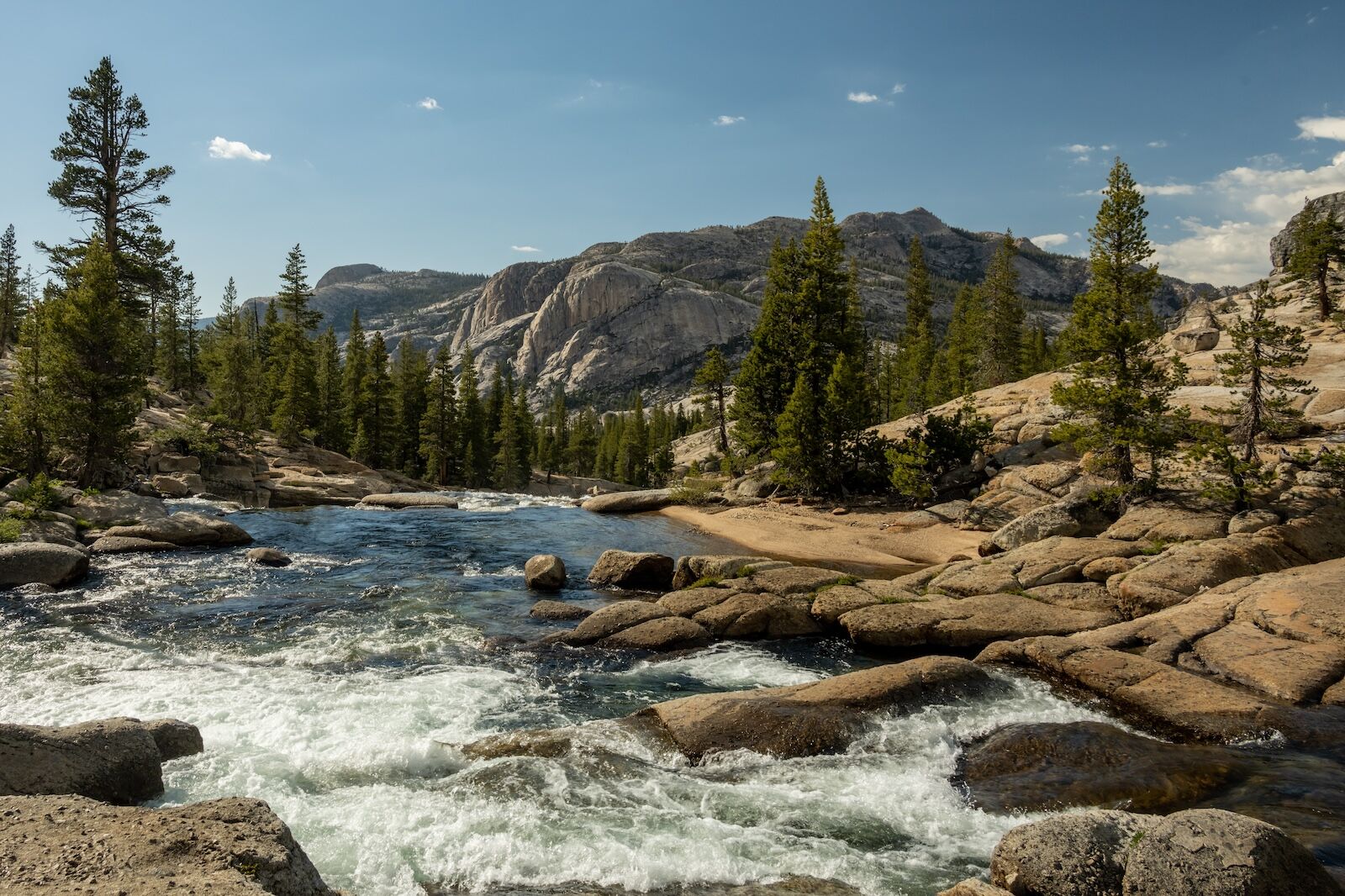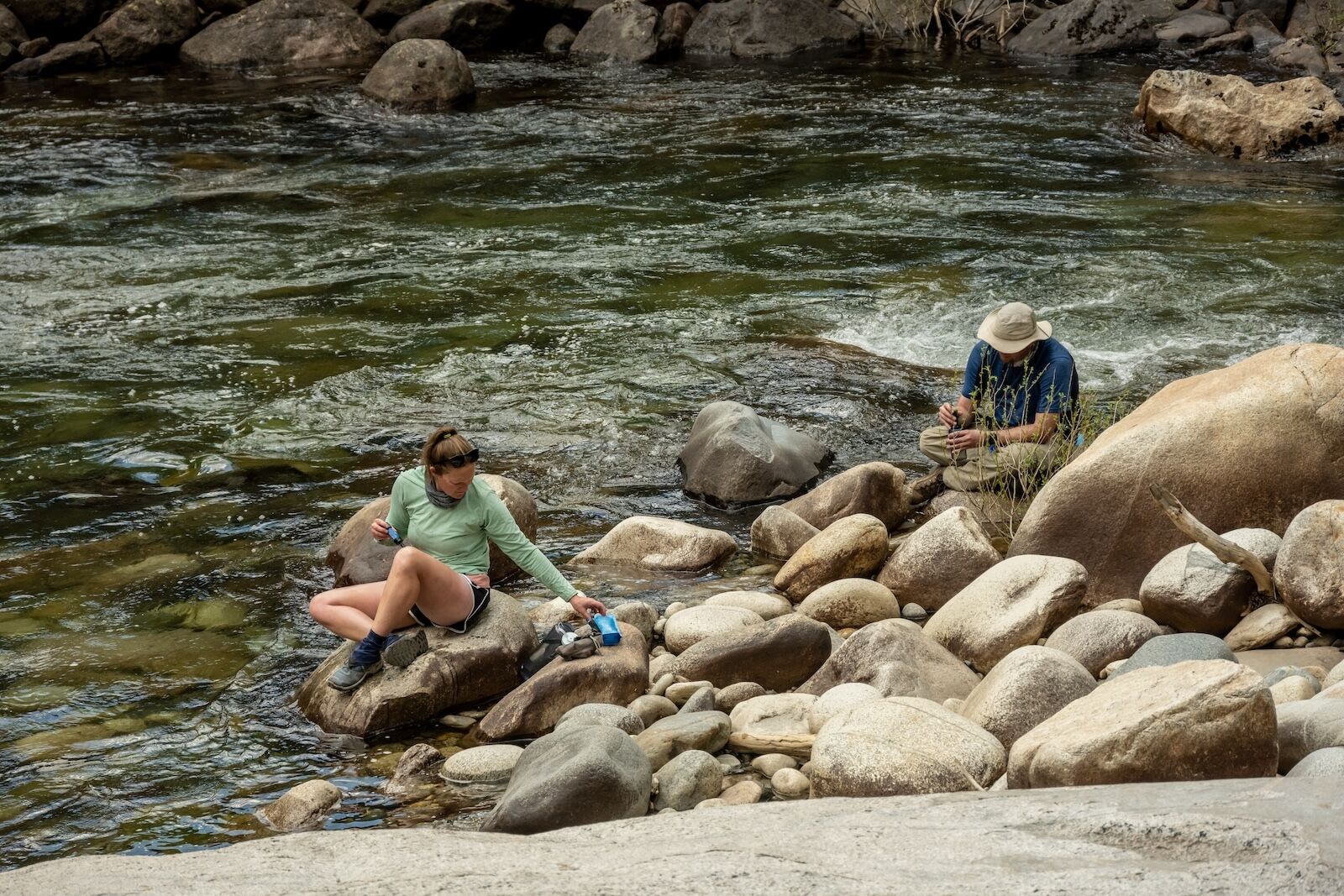Standing before the Tuolumne Wild and Scenic River in Northern California’s Stanislaus National Forest, preparing to raft it for the first time, I felt a mix of emotions: excitement, anxiety, some fear, a calmness inspired by the natural setting. With my first paddle stroke, those feelings dissipated. Present tense entered the time space as I focused on paddling instructions from my group’s rafting guides. It was in that space that we began our journey into river time.


On Northern California's Tuolumne River, Time Stands Still on a Two-Day Whitewater Rafting Trip
Led by OARS, a respected outdoor adventure company, our group filled three rafts: six to a boat, plus one guide per boat and three additional supply rafts. For some in the group, it was their first whitewater rafting experience. The water in August, when we embarked on our trip, is more accessible for beginners than it is in spring.
Before us were two days of rapids, leisurely floating, bluebird skies, golden-grassed canyon walls reaching for the sun, and no cell service. There was nothing to do but wait for our guides to tell us when and how to paddle as we ran numerous whitewater rapids on a remote 18-mile stretch of Tuolumne River west of Yosemite National Park.

Photo: Garrett Morrow Prints/Shutterstock
The first few sets of rapids we rafted were relatively approachable. It was like riding a wet rollercoaster down the river. Smiles and cheers lifted in the late morning air. Surveying the scenery between rapids, I kept thinking about the concept of time. A river makes its way through a mountain of rock, existing for eons. But the river knows no time; it only goes, courses, pushes on.
Pulling up to a spit of rock and sand, we stopped for lunch, a spread of deli meats for sandwiches, crunchy potato chips, and fresh-cut fruit. We ate cookies for dessert and lounged with contented bellies in the scant shade. While rafters are welcome to bring their own snacks, OARS provides and prepares all of the food you’ll need during your trip, accounting for any dietary restrictions group members may have.
After lunch, what is perhaps the river’s most anticipated rapid was not far ahead. Clavey Falls is a nine-foot drop over a cascade of frothy whitewater that spills over and around boulders, creating bumps and holes, making lines for the guides to run the rafts down. Looking ahead, we couldn’t see the actual rapid. What we did see was one of the supply rafts and its solo captain disappear into a seeming abyss. We then dropped into the abyss, bouncing to the bottom and feeling a sense of relief that we ran it unscathed.
Below the falls, we pulled over and scrambled out of the rafts and up the rocks. This was the starting point of a side hike to a swimming hole on the Clavey River, a tributary of the Tuolumne. We walked for 10 minutes until we reached a pool with a boulder to jump off. We waded in the pool, keeping cool in the mountain river on a summer day while bugs buzzed.
By the middle of the afternoon, our OARS flotilla paddled up to an expansive sandy beach. This would be our camp for the night. Oaks stretched their arms, providing much needed shade. We set up chairs in a shallow pool, dipping our feet in the cool water as conversation filled the air. Some members of the group swam; others jumped off rocks into the river. Beers flowed, along with non-alcoholic options like kombucha and seltzer waters.
Dinner started with tortilla chips, salsas, and a bowl of freshly made guacamole that our group of ravenous rafters quickly scraped clean. As the guides prepared beef and chicken fajitas with rice and beans, we set up our sleeping arrangements for the night. OARS provides camping gear for rafters (along with a waterproof overnight bag where you can pack a change of river clothes, camp clothes, toiletries, sun protection, electronics, and books or other personal items). Yet not one person in the group opted to use a tent that night. Collectively, we decided to dream under the stars, after enjoying s’mores and laughter.
With no phone screens in sight, I was reminded again about river time. Soon the moon ascended its arc, rising over the ridgeline while stars emerged. Lying in my river camp bed, my eyes grew heavy as I gazed into the blue-ink, star-filled night sky.

Photo: Kelly vanDellen/Shutterstock
Coffee flowed at 6:30 the next morning. Breakfast was hearty: eggs two ways, scrambled and fried; sausage links; fried potatoes; English muffins; and fresh fruit. The morning passed by in a slow ease. At least one member of the group had brought his rig to fly fish. Others swam or read books. Some of us opted to go on a short hike to see an abandoned gold mine.
Somehow, it was time to eat again. We ate pan-Asian-inspired chicken and cabbage salad, rolled wraps, and munched on chips before filling our OARS-provided water bottles and preparing to depart. We ran more rapids, jumped off boulders, and fell overboard to float on the gentle current. It was a miniscule moment in time but a grand reminder of how momentous life can be.
Next, the Tuolumne Wild and Scenic River — an official designation that comprises 83 miles of the larger river — defined itself for a three-quarter-mile stretch of rapids called Grey’s Grindstone. There’s not a more beautiful river segment to be seen: water meets rock, canyon meets sky, everything glistens and roars while birds soar and fish swim. Such sights are a critical reminder of why we need policy to protect rivers.
I thought of the legacy of David Brower, the famous environmentalist who once said, “We must begin thinking like a river if we are to leave a legacy of beauty and life for future generations.”
Merganser ducks entertained our rafting group as we reached our endpoint, two days on the Tuolumne coming to a close. We spotted a large nest high up in a tree above the river. Then, its maker, a bald eagle perched on a limb. Soon we were all back to doing what we did prior to the trip: turning on our phones and checking in with loved ones.
The river was still there, of course. It was doing what it does, finding its way to wherever. And if you’re fortunate enough to raft it, you realize quickly that the Tuolumne is not just a physical presence. It courses its way into those other places and spaces, the ones within us that we haven’t really figured out yet, but we know they exist.